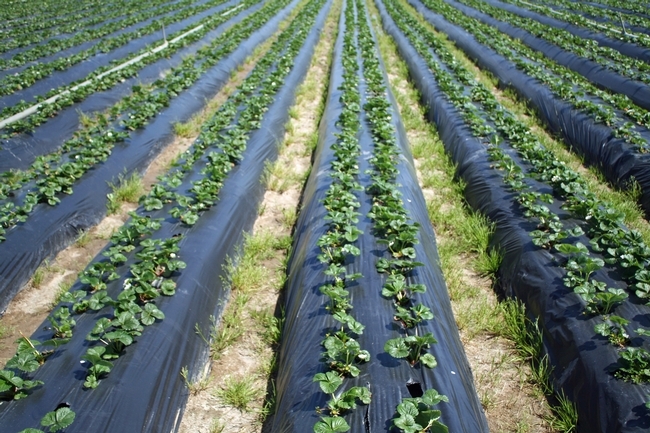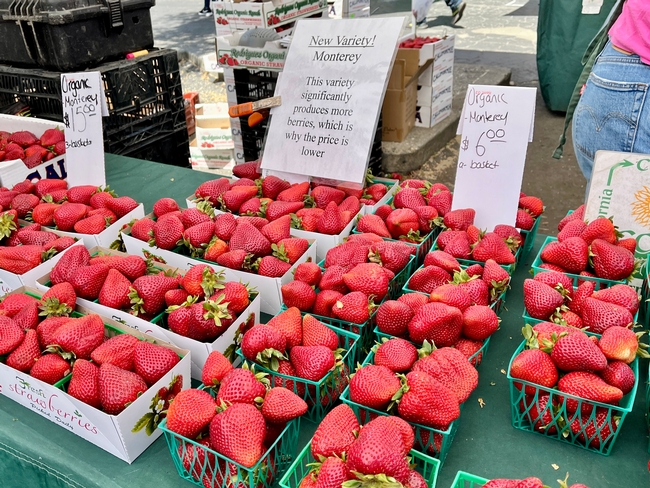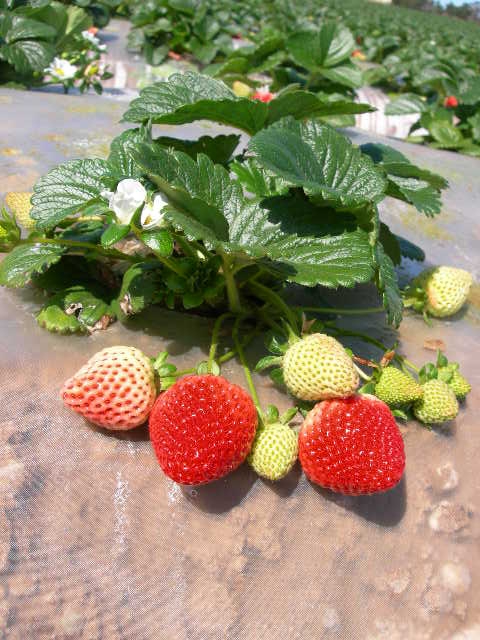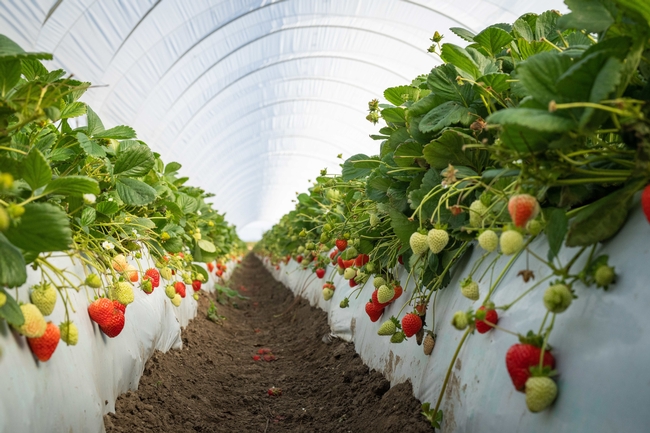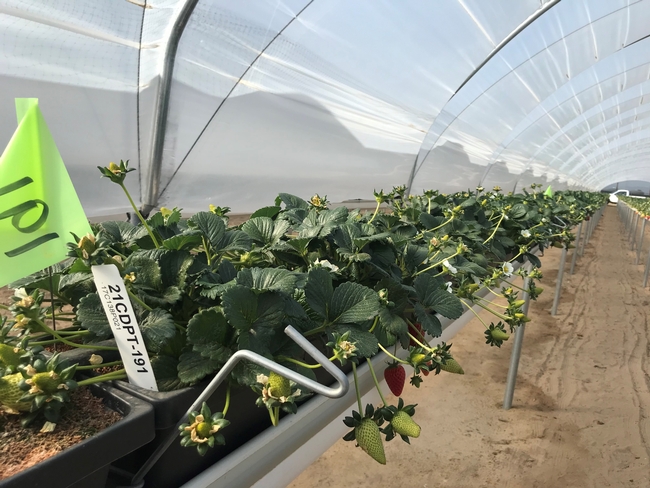Posts Tagged: Strawberries
Lawn-pocalypse! Surviving Drought
Ah, summer! The season of sunburns, pool parties, and… lawn droughts. If your once lush, green carpet now looks like a crunchy brown doormat, you're not alone. Let's dive into why your yard is staging a dramatic death scene and what you can do to...

Bermuda grass and weeds overtaking drought stressed turf grass.
New UC study estimates costs for growing coastal organic strawberries
A new study that can help growers and other readers estimate costs and potential returns for Central Coast organic strawberries was recently released by UC Agriculture and Natural Resources, UC Cooperative Extension and the UC Davis Department of Agricultural and Resource Economics.
“This study provides growers with a baseline to estimate their own costs, which can help when applying for production loans, projecting labor costs, securing market arrangements, or understanding costs associated with water and nutrient management and regulatory programs,” said Brittney Goodrich, UC Cooperative Extension specialist and study co-author.
The cost study models a management scenario for a 30-acre farm, 27 acres of which are planted to organic strawberries. The remaining acres are for the irrigation system, roads, and buildings. The study describes the cultural practices used in organic strawberry production and harvest, including land preparation, soil fertility and pest management, irrigation and labor needs.
The 20-page study shows costs for each operation, material inputs and costs, and cash and non-cash overhead costs in a variety of formats for one production and harvest cycle. A ranging analysis is also included and shows potential profits or losses over a range of prices and yields.
The new study, “2024 Sample Costs to Produce and Harvest Organic Strawberries,” can be downloaded from the UC Davis Department of Agricultural and Resource Economics website at https://coststudies.ucdavis.edu.
For a detailed explanation of the assumptions and calculations used to estimate the costs and potential returns for each crop, readers can refer to the narrative portion of each study.
Sample cost of production studies for many other commodities grown in California are also available at https://coststudies.ucdavis.edu.
For more information about the organic strawberry cost study, contact Mark Bolda, University of California Cooperative Extension farm advisor, at mpbolda@ucanr.eduor Jeremy Murdock in the Department of Agricultural and Resource Economics at jmmurdock@ucdavis.edu.
New UC study estimates costs for growing strawberries on the Central Coast
A new study that can help growers and other readers estimate costs and potential returns for growing strawberries on California's Central Coast was recently released by UC Agriculture and Natural Resources, UC Cooperative Extension and the UC Davis Department of Agricultural and Resource Economics.
“This study provides growers with a baseline to estimate their own costs, which can help when applying for production loans, projecting labor costs, securing market arrangements, or understanding costs associated with water and nutrient management and regulatory programs,” said Brittney Goodrich, UC Cooperative Extension specialist and study co-author.
The cost study models a management scenario for a 50-acre farm, 45 acres of which are planted to strawberries, located in Santa Cruz, Monterey or San Benito counties. The remaining acres are for the irrigation system, roads and buildings. The study describes the cultural practices used in strawberry production and harvest, including land preparation, soil fertility and pest management, irrigation and labor needs.
The 19-page study shows costs for each operation, material inputs and costs, and cash and non-cash overhead costs in a variety of formats for one production and harvest cycle. A ranging analysis is also included and shows potential profits or losses over a range of prices and yields.
The new study, titled “2024 Sample Costs to Produce and Harvest Strawberries” can be downloaded from the UC Davis Department of Agricultural and Resource Economics website at https://coststudies.ucdavis.edu.
For a detailed explanation of the assumptions and calculations used to estimate the costs and potential returns for each crop, readers can refer to the narrative portion of each study.
For more information, contact Mark Bolda, University of California Cooperative Extension farm advisor, at mpbolda@ucanr.edu, or Jeremy Murdock in the Department of Agricultural and Resource Economics at jmmurdock@ucdavis.edu.
Sample cost of production studies for many other commodities grown in California are also available at https://coststudies.ucdavis.edu.
Climate-Change Resources
University of California UC ANR Green Blog (Climate Change and Other Topics) https://ucanr.edu/blogs/Green/index.cfm?tagname=climate%20change (full index)
Examples:
- Save Trees First: Tips to Keep Them Alive Under Drought https://ucanr.edu/b/~CdD
- Landscaping with Fire Exposure in Mind: https://ucanr.edu/b/~G4D
- Cities in California Inland Areas Must Make Street Tree Changes to adapt to Future Climate https://ucanr.edu/b/~oF7
Drought, Climate Change and California Water Management Ted Grantham, UC Cooperative Extension specialist (23 minutes) https://youtu.be/dlimj75Wn9Q
Climate Variability and Change: Trends and Impacts on CA Agriculture Tapan Pathak, UC Cooperative Extension specialist (24 minutes) https://youtu.be/bIHI0yqqQJc
California Institute for Water Resources (links to blogs, talks, podcasts, water experts, etc.) https://ciwr.ucanr.edu/California_Drought_Expertise/
UC ANR Wildfire Resources (publications, videos, etc.) https://ucanr.edu/News/For_the_media/Press_kits/Wildfire/ (main website)
-UC ANR Fire Resources and Information https://ucanr.edu/sites/fire/ (main website)
-Preparing Home Landscaping https://ucanr.edu/sites/fire/Prepare/Landscaping/
UC ANR Free Publications https://anrcatalog.ucanr.edu/ (main website)
- Benefits of Plants to Humans and Urban Ecosystems: https://anrcatalog.ucanr.edu/pdf/8726.pdf
-Keeping Plants Alive Under Drought and Water Restrictions (English version) https://anrcatalog.ucanr.edu/pdf/8553.pdf
(Spanish version) https://anrcatalog.ucanr.edu/pdf/8628.pdf
- Use of Graywater in Urban Landscapes https://anrcatalog.ucanr.edu/pdf/8536.pdf
- Sustainable Landscaping in California https://anrcatalog.ucanr.edu/pdf/8504.pdf
Other (Non-UC) Climate Change Resources
Urban Forests and Climate Change. Urban forests play an important role in climate change mitigation and adaptation. Active stewardship of a community's forestry assets can strengthen local resilience to climate change while creating more sustainable and desirable places to live. https://www.fs.usda.gov/ccrc/topics/urban-forests
Examining the Viability of Planting Trees to Mitigate Climate Change (plausible at the forest level) https://climate.nasa.gov/news/2927/examining-the-viability-of-planting-trees-to-help-mitigate-climate-change/
Reports and other information resources coordinated under the auspices of the United Nations and produced through the collaboration of thousands of international scientists to provide a clear and up to date view of the current state of scientific knowledge relevant to climate change. United Nations Climate Action
Scientific reports, programs, action movements and events related to climate change. National Center for Atmospheric Research (National Science Foundation)
Find useful reports, program information and other documents resulting from federally funded research and development into the behavior of the atmosphere and related physical, biological and social systems. Search and find climate data from prehistory through to an hour ago in the world's largest climate data archive. (Formerly the "Climatic Data Center") National Centers for Environmental Information (NOAA)
Think tank providing information, analysis, policy and solution development for addressing climate change and energy issues (formerly known as the: "Pew Center on Global Climate Change"). Center for Climate & Energy Solutions (C2ES)
Mapping Resilience: A Blueprint for Thriving in the Face of Climate Disaster. The Climate Adaptation Knowledge Exchange (CAKE) was launched in July 2010 and is managed by EcoAdapt, a non-profit with a singular mission: to create a robust future in the face of climate change by bringing together diverse players to reshape planning and management in response to rapid climate change. https://www.cakex.org/documents/mapping-resilience-blueprint-thriving-face-climate-disaster
Cal-Adapt provides a way to explore peer-reviewed data that portrays how climate change might affect California at the state and local level. We make this data available through downloads, visualizations, and the Cal-Adapt API for your research, outreach, and adaptation planning needs. Cal-Adapt is a collaboration between state agency funding programs, university and private sector researchers https://cal-adapt.org/
Find reports, maps, data and other resources produced through a confederation of the research arms of 13 Federal departments and agencies that carry out research and develop and maintain capabilities that support the Nation's response to global change. Global Change (U.S. Global Change Research Program)
The Pacific Institute is a global water think tank that combines science-based thought leadership with active outreach to influence local, national, and international efforts to develop sustainable water policies. https://pacinst.org/our-approach/
Making equity real in climate adaptation and community resilience policies and programs: a guidebook. https://greenlining.org/publications/2019/making-equity-real-in-climate-adaption-and-community-resilience-policies-and-programs-a-guidebook/
Quarterly CA Climate Updates and CA Drought Monitor Maps (updated each Thursday) https://www.drought.gov/documents/quarterly-climate-impacts-and-outlook-western-region-june-2022
UC Davis releases 5 strawberry varieties resistant to deadly fungal disease
Strawberries selectively bred for Fusarium wilt resistance and high yields
The University of California, Davis, is releasing five new strawberry varieties that are resistant to the soilborne disease Fusarium wilt, have high yields and improved fruit quality.
UC Eclipse, UC Golden Gate, UC Keystone, UC Monarch and UC Surfline will be available for sale to California nurseries from Foundation Plant Services in April.
Roughly 88% of strawberries grown in the nation come from California. Fusarium wilt is one of the most common reasons for crop loss and death and yet 55 to 59% of cultivars planted in the state since 2014 have not been resistant, according to UC Davis research.
This is the first release from the UC Davis Strawberry Breeding Program where all the cultivars have Fusarium wilt resistance. They are meant to replace susceptible plants on the market such as Monterey, UCD Royal Royce and UCD Valiant.
Monarch was also developed specifically as a prototype for mechanical harvesting – another first out of the breeding program, which dates to the 1930s and has released 72 patented cultivars over the decades.
“These provide the same yield or better and they are Fusarium resistant,” said Steve Knapp, a Distinguished Professor in the Department of Plant Sciences and director of the UC Davis Strawberry Breeding Program. “They have a better collection of traits. They're superior.”
Knapp is a faculty member based in the College of Agricultural and Environmental Sciences at UC Davis and shares the UC Agriculture and Natural Resources land-grant mission of the Agricultural Experiment Station.
Dangerous pathogen
Fusarium wilt didn't present much of a danger to strawberry crops until after the fumigant methyl bromide was phased out of use in the United States in 2005. But the pathogen had always been in the soil, and cases of wilt appeared a year later and increased over time, leading to concerns that a Fusarium wilt pandemic could destroy the crop in California.
“The disease has taken off fast and we need to react quickly to address the need,” said Glenn Cole, a breeder and field manager with the Strawberry Breeding Program.
Knapp said the program tries to “encourage people to consider things like disease resistance” and routinely invites growers and other experts to events showcasing research breakthroughs and improved cultivars.
Varieties for the seasons
The new strawberry varieties each have improved flavor and characteristics that allow for near year-round growing around California, where about 1.8 billion pounds of the fruit are harvested each year. Some of the cultivars are adapted for production in the southern part of the state while others do well under the long daylight hours of summer along the coast.
Eclipse, a “summer plant” cultivar, has the potential to increase grower profitability as it produces in the fall and winter, and yields during research testing were 54% higher than similar cultivars. “We expect this cultivar to have wide commercial appeal,” Knapp said. “Eclipse is going to eclipse them all.”
Golden Gate and Keystone are “day neutral.” Those type of cultivars grow throughout the summer on about 60 percent of strawberry farming acres in the state. The “short-day” plants Surfline and Monarch are resistant to Verticillium wilt and Phytophthora crown rot.
Surfline and Eclipse are firmer and promise longer shelf lives. Monarch provides growers with improved fruit qualities relative to other mass-producedcultivars and has characteristics needed for advances in mechanical harvesting, Knapp said.
Genetic tools
Breeding program experts have long been researching ways to improve strawberry cultivars so the crop can withstand pests, disease and other stressors. To find plants that had Fusarium wilt resistance, they obtained the DNA of thousands of plants in field studies. The scientists also developed genetic tools to screen the plants and identify the genes that have resistance to the Fusarium pathogen.
Knowing that information allowed the team to breed resistance into and develop new cultivars, at a faster rate than previous efforts. “These tools have allowed us to sweep out the susceptibility and bring in resistance,” Knapp said.

